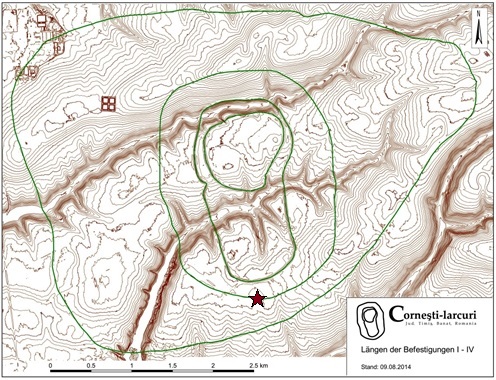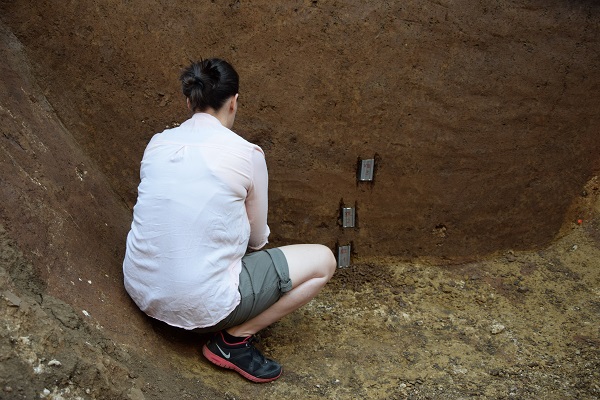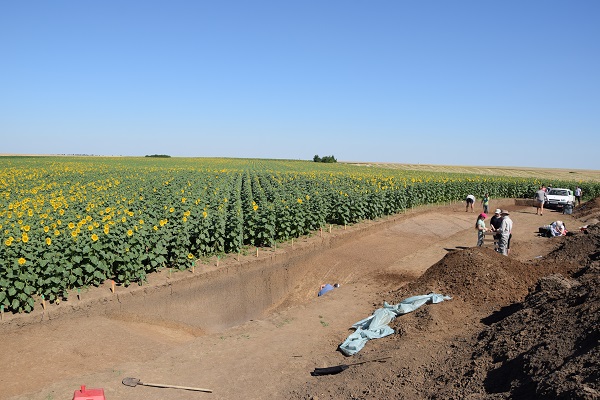Excavation at the huge fortification of Corneşti-Iarcuri in romanian Banat (RO)
Within our LOEWE research project on Bronze Age hillforts in Europe, a second campaign in the late Bronze Age (14.-11. centuries BC) fortification of Corneşti-Iarcuri in the Romanian Banat was carried out in June and July 2017. In 2016, the second enclosure was sectioned and the buildup and dating of the wood and earth rampart was successfully analysed (for further information about the fortification of Cornesti and the 2016-campaign)
 |
In 2017 the excavations focused on the southern part of the third enclosure (marked with star on the picture). The third enclosure has never been archaeologically inves-tigated. Its dating and inner architecture therefore became important questions to be answered through our campaign. In the research area, a rest of the wood and soil construction was still preserved. The geomagnetic survey, which took place before excavations, constitutes as a major source of data. In order to investigate the defen-sive ditch and the rampart as mentioned above a 50 meter long trench in north-south orientation was dug utilising a backhoe. |
| Picture 1: Corneşti-Iarcuri, Localization of the excavation trench in 2017 sectioning the third enclosure |
| Due to its huge dimensions, the ditch has been excavated through the help of a backhoe: The bottom of the ditch is 4,70 m below todays upper soil (Picture 2). | |
| Picture 2: Corneşti-Iarcuri 2017, Profile from the defensive ditch surrounding the third enclosure (Corneşti-Iarcuri-Projekt Frankfurt/Berlin, Foto H. Blitte) |
| Within the various layers of its filling at a depth of approximately 3,50 m, a cultural layer appeared, containing animal bones, human bones and ceramics (Picture 3) | |
| Picture 3: Corneşti-Iarcuri 2017, Ceramic in the filling of the ditch (Corneşti-Iarcuri-Projekt Frankfurt/Berlin, Foto H. Blitte) |
| It is not clear yet if these remains are to be interpreted as disposed garbage or an intentional deposition. Nevertheless, the layer seems to occur after a first brief abandonment of the ditch or at least a phase without any maintenance. The chrono-logical classification of the cultural layer and its consecutive ditch phase will take place through radiocarbon dating. All layers of the ditch have been massively sam-pled, for archaeobotanical and micromorphological analysis |  |
| Picture 4: Corneşti-Iarcuri 2017, Extraction of soil samples from different layers of the ditch for micromorphological analyses (Corneşti-Iarcuri-Projekt Frankfurt/Berlin, Foto H. Blitte) |
 |
The section through the enclosure yields plenty of clues on the design of the inner wood construction obtained from traces of beams and postholes. From these obser-vations, it is possible to reconstruct a wooden box structure, similar to what was was previously observed from the former sections through the other enclosures. |
| Picture 5: Corneşti-Iarcuri 2017. Overview of the rampart and the defensive ditch (Corneşti-Iarcuri-Projekt Frankfurt/Berlin, Foto H. Blitte). |
From a detailed analysis of the construction features from the wood and earth ram-parts of the various enclosures in connection with our broad series of radiocarbon dates we aim to achieve major conclusions on the building history of the various enclosures of Corneşti-Iarcuri. This might lead to a determination on the function of this inflated prehistoric fortification.
(Authors Hélène Blitte and Rüdiger Krause, September 2017)



